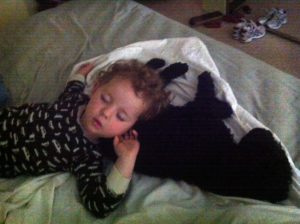By: Helen Stevens
Tracy G. Cassels
Wendy Middlemiss
Darcia Narvaez
Sarah Ockwell-Smith
John Hoffman
James McKenna
Kathleen Kendall-Tackett
Click here for Part 1 covering Understanding Toddler Sleep
Why Do Toddlers Wake?
 The brain of a toddler is capable of complex processes and there may be many reasons a toddler wakes and signals, or calls/cries out. Reasons can include having bad dreams, waking up and being uncomfortable with the dark, or just wanting comforting attention. A new experience a toddler has during the day can even cause additional waking and signalling overnight. Emotional and physical factors can cause wakefulness beyond what is normal. Parents may worry that prolonged sleep without toddlers’ waking and calling for, or coming to the parent for, attention will always continue. In the midst of wakeful nights, tiredness and the pressure of everyone around saying that toddlers should sleep through the night, it is easy for parent to fall into the trap of disciplining and harsh measures to ‘get the toddler to sleep through’. The knowledge that the toddler needs comforting and kindness often slips to the background for tired families.
The brain of a toddler is capable of complex processes and there may be many reasons a toddler wakes and signals, or calls/cries out. Reasons can include having bad dreams, waking up and being uncomfortable with the dark, or just wanting comforting attention. A new experience a toddler has during the day can even cause additional waking and signalling overnight. Emotional and physical factors can cause wakefulness beyond what is normal. Parents may worry that prolonged sleep without toddlers’ waking and calling for, or coming to the parent for, attention will always continue. In the midst of wakeful nights, tiredness and the pressure of everyone around saying that toddlers should sleep through the night, it is easy for parent to fall into the trap of disciplining and harsh measures to ‘get the toddler to sleep through’. The knowledge that the toddler needs comforting and kindness often slips to the background for tired families.
Helping Toddlers Sleep May Mean Knowing When They are Tired
How can you know if a toddler is not sleeping because they aren’t tired enough to sleep… and when they are tired? Tired children will exhibit signs that they are sleepy. Toddlers may fight sleep and bedtime because there is so much that to do. But overtired toddlers will have more difficulty settling. It is important then, to get toddlers to bed before they are overtired. Parents can watch for the signs of sleepiness…
Being Grumpy. When sleepy, toddlers become less tolerant of change and more emotionally reactive, easily bored and cannot hold interest in play and sometimes grizzling.
Being Jumpy. Toddlers, when tired, may become more reactive to sudden noises, even jerky movements may be seen.
Just Staring. Toddlers may begin to transition to sleep, just as infants had, with a change in alertness. With this they may have moments of fixed gaze, not focused on anything, just staring. Sometimes briefly, sometimes longer.
Being Clumsy. As toddlers get more tired they may fall, tip from side to side, or drop things more readily.
Look Tired. When tired, some toddlers’ bright complexions become pale and dull and dark areas around the eyes develop.
Unusually Cuddly or not Cuddly at all. When very sleepy, toddlers may seek the comfort of more cuddles, or they may be less easily cuddled or comforted.
To help with toddlers’ transition to sleep and nighttime routine, it is good to get toddlers to bed before a parent sees these signs. This may help with toddlers’ being able to settle and toddlers sleeping peacefully. One of the most successful things parents can do is implement a bedtime routine that is catered to the specific child. It has been found that implementing a bedtime routine can decrease the time to sleep onset for toddlers while having the added benefit of improving mom’s mood (Mindell, Telofski, Wiegand, & Kurtz, 2009).
Click here for Part 3 which will cover Helping Toddlers Prepare for Sleep
Mindell, J.A., Telofski, L.S., Weigand, B., & Kurtz, E.S. (2009). A nightly bedtime routine: impact on sleep in young children and maternal mood. Sleep, 32, 599-606.






One thing that I’m also a tiny bit worried about is the total amount of sleep my toddler (now 20 months old) gets. The range is about 10.5 to 12 hours total sleep per day (nap plus night time) which I keep hearing is too little. But she doesn’t strike me as being tried and her night sleep varies from maybe one waking to 3-4, all very brief. We bed share. Is there any chance you could shed some light on total sleep duration, if it’s something that is worth worrying about, etc. Thanks!
I had a bit on total sleep duration in the infant sleep series that actually would be quite fitting here! Basically, don’t worry 🙂 Provided there are no signs of sleep deprivation, total sleep duration is still a highly variable thing with some kids needing less (or more) than others. In fact, one little tidbit I came across by a researcher who studied total sleep duration recommendations across the years is that they are a) totally arbitrary, not based on science, and b) always higher than the average amount of sleep infants and toddlers are getting. Hopefully that helps 🙂
The variable amount of sleep is Sooo true. My two older kids vary drastically. The boy needs 9-10 hours to function well, he’s 11. The girl needs 11-12 hrs per night. She’s 10. And the amount of sleep they require has changed with growth spurts, activity level, diet, life changes. Etc. Even the toddler sleep patterns and length sometimes change.
Thank you, it does! I’ll try to think of it as just another thing ‘baby experts’ make you worry about needlessly.
[…] https://gku.flm.mybluehost.me/evolutionaryparenting.com/understanding-and-helping-toddler-sleep-part-ii/ […]
Is it normal for a toddler to wake in the middle of the night, after about 4-5 hours of sleep (waking briefly once or twice during that duration) and being super restless? Bedshare and still breastfeed 19 month old. No physical issues or big changes occurring in life. He’ll nod off then wake after 5 mins for about an hour to 2. At the moment has all his teeth (until next round of molars). Room isn’t too hot or cold. I’ll try rocking and breastfeeding but can’t seem to go back to sleep as easy as rest of night…
Yep – lots of toddlers go through biphasic sleep at this time. However, it can also be due to lower than ideal levels of magnesium, hunger, etc. But it’s certainly normal even if there are some causes than can be addressed and some you have to wait out 🙂